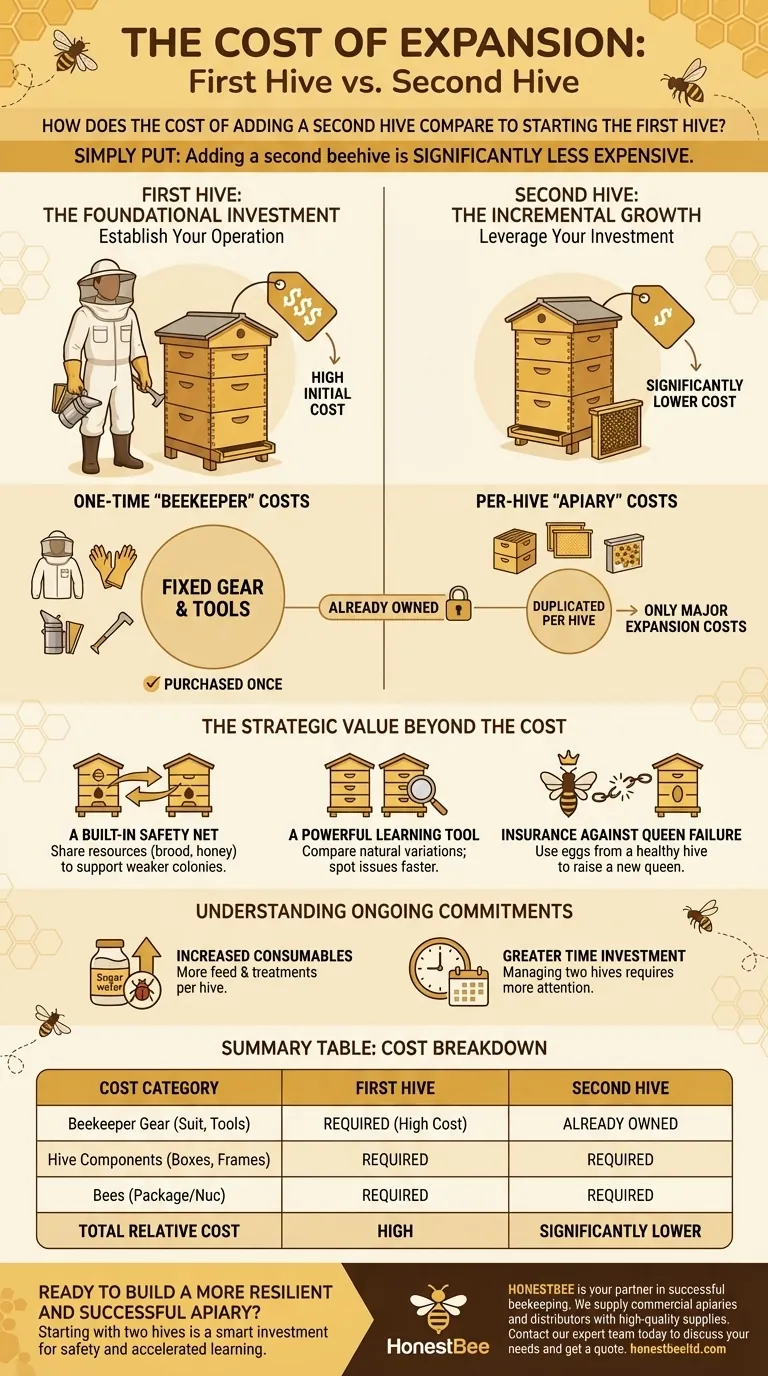To put it simply, adding a second beehive is significantly less expensive than starting your first one. The high initial cost of beekeeping comes from one-time purchases of personal gear and tools. Once you have that "beekeeper's infrastructure," the cost of expansion drops dramatically, focusing only on the hive and the bees themselves.
Your first hive establishes your beekeeping operation by covering the fixed, one-time costs of tools and protective gear. Every subsequent hive is an incremental cost, allowing you to leverage your initial investment for greater resilience and learning.

Deconstructing the Cost: First Hive vs. Second Hive
The key to understanding the price difference is to separate the costs into two categories: expenses for the beekeeper and expenses for the apiary.
The One-Time "Beekeeper" Costs
When you start your first hive, a large portion of the budget goes toward equipment you will use for your entire apiary, regardless of how many hives you have.
These foundational purchases include your protective gear (suit, veil, gloves) and your essential hive tools (smoker, hive tool). You only need one set of these, making them the primary reason your first hive is the most expensive.
The Per-Hive "Apiary" Costs
These are the costs that are duplicated each time you add a new colony to your yard.
For a second hive, you will need to purchase another complete set of hive components (bottom board, boxes, frames, and covers) and a new colony of bees, either as a package or a nucleus hive (nuc). These are the only major costs associated with expansion.
The Strategic Value Beyond the Cost
While the financial savings are clear, the most compelling reason to add a second hive isn't about money. It's about dramatically increasing your chances of success.
A Built-In Safety Net
With two hives, you have management options that are impossible with just one. A strong hive can be used to support a weaker one by sharing resources like frames of brood or honey. This can prevent a struggling colony from failing.
A Powerful Learning Tool
Running two hives side-by-side provides an invaluable point of comparison. It helps you understand the natural variations between colonies and more easily spot when one hive's development is falling behind, indicating a potential problem.
Insurance Against Queen Failure
If one colony unexpectedly loses its queen, you can use a frame of eggs from your healthy hive to allow the queenless colony to raise a new emergency queen. This simple action can save a colony that would otherwise be doomed.
Understanding the Ongoing Commitments
Adding a second hive is not without its trade-offs. While the initial equipment cost is lower, your ongoing operational needs will increase.
Increased Consumables
You will need more feed (sugar water or fondant) if conditions require it and more mite treatments to keep both colonies healthy. These are direct per-hive costs that will scale with your apiary.
Greater Time Investment
Managing two hives naturally takes more time than one. Inspections, feeding, and seasonal management tasks will all require more of your attention.
Making the Right Choice for Your Goals
Deciding when to add a second hive depends on your primary objective as a new beekeeper.
- If your primary focus is minimizing the initial investment: Start with one hive to spread the cost out, but understand the risks and be prepared to troubleshoot problems without the support of a second colony.
- If your primary focus is maximizing your chance of long-term success: Starting with two hives provides an essential safety net and accelerates your learning curve far more effectively than starting with one.
Ultimately, viewing your second hive not as an expense but as an investment in your apiary's health is the most effective path to becoming a confident beekeeper.
Summary Table:
| Cost Category | First Hive | Second Hive |
|---|---|---|
| Beekeeper Gear (Suit, Smoker, Tools) | Required | Already Owned |
| Hive Components (Boxes, Frames) | Required | Required |
| Bees (Package/Nuc) | Required | Required |
| Total Relative Cost | High | Significantly Lower |
Ready to build a more resilient and successful apiary?
As a new beekeeper, starting with two hives is one of the smartest investments you can make. It provides a crucial safety net for your colonies and dramatically accelerates your learning.
HONESTBEE is your partner in successful beekeeping. We supply commercial apiaries and beekeeping equipment distributors with the high-quality, durable supplies needed to build and maintain a thriving operation. Let us help you get the right equipment for your expansion goals.
Contact our expert team today to discuss your needs and get a quote on hive components and beekeeping essentials.
Visual Guide

Related Products
- HONESTBEE Advanced Ergonomic Stainless Steel Hive Tool for Beekeeping
- Professional Dual-End Stainless Steel Hive Tool for Beekeeping
- Professional Galvanized Hive Strap with Secure Locking Buckle for Beekeeping
- Professional 3-Bar Frame Grip with Integrated Hive Tool
- Plastic Bee Hive Stand for Beekeeping
People Also Ask
- What is the hole in a hive tool for? A Multi-Tool for Apiary Repairs and Maintenance
- How is a hive tool used for scraping and cleaning? Master Hive Maintenance for a Healthy Colony
- Why do hive tools have a hole? Unlock the Secret to Efficient Beekeeping
- What is a hive tool and what are its uses? Master Your Hive Inspections with the Essential Beekeeper's Tool
- What are some common uses of a hive tool? Essential Multi-Purpose Tool for Every Beekeeper



















